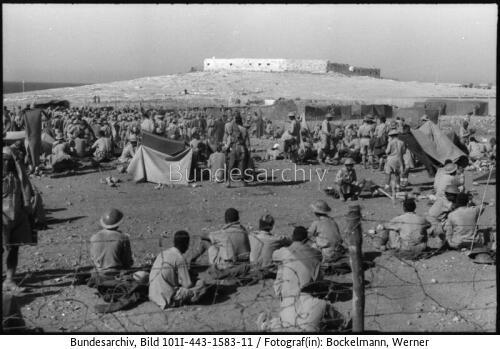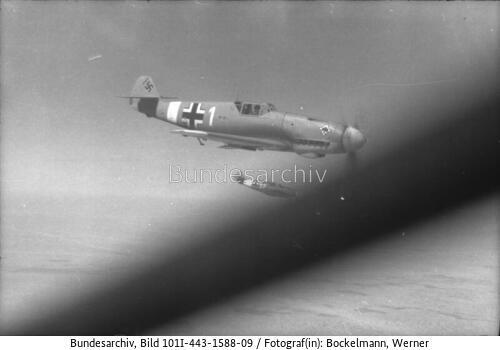Thursday 18 June 1942
 |
| Erwin Rommel in North Africa, 18 June 1942 (Gemini, Ernst A., Federal Archives Image 146-2002-010-05A). |
Eastern Front: The German advance toward Sevastopol, Crimea, gains a second wind on 18 June 1942 following the fall of key Soviet fortress Maxim Gorki north of Severnaya Bay. Luftwaffe operations over the port become much less hazardous as bombers of KG 51 destroy an effective Soviet anti-aircraft platform in the bay.
The Germans continue their mopping up of Soviet resistance north of the bay. The 132nd Infantry Division accepts the surrender of the Soviet 95th Rifle Division and Coastal Battery 12 at 09:00, while the 24th Infantry Division captures Bartenyevka at the mouth of the bay and the 22nd ID catches up with them. The Soviet defenders counterattack with the 138th Naval Brigade, which has no artillery or air support and is wiped out. In the south, the Wehrmacht attack remains stalled before Sapun Ridge, though Romanian troops are moving up the Chernaya River toward Sevastopol.
At Fuhrer Headquarters, Hitler has returned from his vacation. General Franz Halder briefly notes in his war diary the success at Sevastopol, but lavished much more ink on the partisan situation farther north:
In [Army Group] Center, [Soviet] Corps Belov ... has been split into several groups. We must reckon with the ability of some elements to fight their way through the forests toward Kirov, and that the enemy at Kirov will support these breakout attempts by launching an attack of his own.
He also notes in passing that the Soviet troops trapped on the Volkhov "are running short of food."
Battle of the Black Sea: German Kriegsmarine motor torpedo boat S 102 torpedoes and sinks 2048-ton Soviet freighter Belostok near Balaklava, Crimea. There are 388 deaths.
An Italian mini-submarine scores another success when it sinks another Soviet submarine sailing on the surface near Cape Sarych, Crimea. This is the second such sinking in four nights.
 |
| British POWs under guard behind barbed wire, near Bir Hacheim, North Africa, 18 June 1942 (Bockelmann, Werner, Federal Archives Picture 101I-443-1583-11). |
Battle of the Pacific: Three 11th Air Force USAAF B-17s, an LB-30, and four B-24 bombers attack Japanese shipping at Kiska in the Aleutian Islands and sink 6537-ton Japanese oiler Nissan Maru. There is one death. One B-24 is lost with casualties, the Japanese possibly lose two scout planes.
Japanese aircraft raiding Port Moresby bomb and badly damage 4561-ton Australian passenger ship MV Macdhui. There are 10 deaths. The ship's remains are still visible on the reef south of Tatana Island.
Japanese 2206-ton freighter Tairyu Maru runs aground and is wrecked off Gyoji Island, Korea. Casualties are unknown.
 |
| A Bf 109 fighter of JG 53 escorting a reconnaissance plane in North Africa (Bockelmann, Werner, Federal Archive Picture 101I-443-1588-09). |
Battle of the Atlantic: U-159 (Kptlt. Helmut Friedrich Witte), on its second patrol out of Lorient, uses its deck gun to sink 1417-ton Dutch freighter Flora north of Manaure, Colombia. Conserving torpedoes is important on these missions far from home port, so U-boat captains like to use their gun instead of torpedoes even though it is somewhat riskier and less certain. There are one death and 36 survivors, who are briefly questioned by the U-boat crew and then land on the Colombian coast on 19 June. The ship is only in this location because it picked up some survivors from two other recently sunk ships, Surrey and Ardenvohr, and dropped them off at Cristobal.
U-172 (Kptlt. Carl Emmermann), also on its second patrol out of Lorient, similarly uses its deck gun to sink a ship in the Caribbean, this one 1958-ton British tanker Motorex northwest of Colón, Panama. There are one death and 20 survivors. This is a continuation of a quite successful patrol for U-172, which now has sunk seven ships and is running low on torpedoes.
U-124 (Kptlt. Johann Mohr), on its ninth patrol out of Lorient, torpedoes and badly damages U.S. tanker Seattle Spirit south of Greenland/ east of Newfoundland and Labrador. Seattle Spirit is sailing with Convoy ONS-102 in rough seas. The ship is armed, but the sinking takes place too quickly to use the guns. One of four torpedoes hits in the engine room and the ship quickly floods, but the crew and seven Canadian passengers manage to get off in three lifeboats. There are four deaths and 51 survivors, who are picked up by HMCS Agassiz. The Canadian corvette then scuttles Seattle Spirit. After this, Mohr heads back to base having sunk seven ships of 32,429 tons on this patrol.
Royal Navy destroyer HMS Albrighton, accompanied by steam gun boats HM SGB 6, 7, and 8, sinks German minesweeper R 41 during a sweep of the Seine Bay. The British lose SGB 7 during the raid.
During the same action, German 810-ton freighter Turquoise is running from the gunboats when it runs aground six nautical miles (11 km) from Port-en-Bessin-Huppain, Lower Normandy, France. The ship is a total loss.
 |
| A Luftwaffe Lieutenant on the field telephone in front of an Me 110 fighter plane in North Africa near Bir Hacheim, 18 June 1942 (Bockelmann, Werner, Federal Archives Picture 101I-443-1588-11). |
Battle of the Mediterranean: German General Erwin Rommel's panzers advance rapidly against fading British resistance, reaching Gambut (Kambut), Libya. This is the site of a major RAF base, and the airfield is perfectly positioned for the Luftwaffe to bomb Tobruk.
Now on the outskirts of the port, Rommel's troops advance with their 2 German and one Italian armored divisions for a frontal assault after clearing out any pockets of resistance. Rommel's plan is to attack the southeastern perimeter, held by the 2/7th Gurka Rifles at the coast and the 2/5th Mahrattas and 2nd Cameron Highlands further inland, in a couple of days. He will use his two German panzer divisions, 15 and 21 Panzer, near the coast and the Italian Trieste and Ariete Divisions further inland.
British tug SS Vsion sinks at Mersa Matruh, Egypt, of unknown causes. No casualties.
An unusual German rescue concludes when U-83 makes port in Messina, Italy. The U-boat rescued the crew of a downed DO-24T-2 of Seenofstaffel 7 based at Suda (Souda), Crete. The Dornier had rescued a downed Bf-109 pilot, Lt. Heinrich Hesse of 7./JG 53, but then lost its tail while trying to take off and been left floating aimlessly in the Mediterranean. U-83 then was vectored to the Dornier by a passing Heinkel He 111.
 |
| The 18 June 1942 NY Times manages to get every key fact in its headlines wrong in a jingoistic sort of way. |
Spy Stuff: There are now two German spy rings in the United States operating as Operation Pastorius. One ring is in a Manhattan hotel, while the other is traveling north by train from their landing at Ponte Vedra, Florida. The leader of the New York group, George John Dasch, already has begun the process of turning himself and his confederates over to the FBI, but for now, both groups remain unrestrained and with full freedom of action.
POWs: The first of two wartime prisoner exchanges between the Allies and Japan begins today. The U.S. government has chartered the Swedish cruise ship M.S. Gripsholm for such exchanges, and today it leaves with a load of Japanese civilians for Rio de Janeiro and then Mozambique, where the exchange is to be made. Spain represents Japan and Switzerland represents the Allies in these negotiations. The Gripsholm's passengers are mainly Japanese diplomats or businessmen who happened to be in the U.S. when war broke out. The Japanese have brought1554 Allied prisoners there to be picked up by the Gripsholm. The Japanese prisoners are picked up in Mozambique and taken to Japan aboard the Asamu Maru and Conte Verde. The Gripsholm will arrive back in New York on 25 August with its exchanged Allied prisoners. The next exchange will be in August 1943.
German Military: Luftwaffe squadron 7./JG 54 moves to Kotly near Leningrad and begins sweeps to protect German minesweepers in the Gulf of Finland.
Having been placed on leave for getting his 100th victory, Luftwaffe ace Oblt. Hans-Joachim Marseille of 3./JG 27 is informed that he has been awarded the Schwerter (swords) to his Ritterkreuz (Iron Cross). Marseille departs from North Africa for Fuhrer Headquarters on a Junker Ju 52/3m.
 |
| Two Stuart tanks advancing in the Western Desert, 18 June 1942 © IWM E 13534. |
US Military: Bernard Whitfield Robinson becomes the first black U.S. Navy commissioned officer.
The air echelon of the 69th Bombardment Squadron, 38th BG (Medium) flies from Hickam Field in Hawaii with its B-26s to New Caledonia. It will fly reconnaissance missions for the rest of the year.
Major General Carl Spaatz arrives in London to formally take command of Eighth Air Force.
The U.S military begins developing the first medical air evacuation service. This will begin operation later in the year during the construction of the Alcan Highway and in Burma, New Guinea, and Guadalcanal.
German Homefront: Following a lengthy investigation when a partisan provides information in exchange for cash, German troops find and gun down the two assassins of Reichsprotektor of Bohemia and Moravia Reinhard Heydrich. The two men, Jan Kubiš and Jozef Gabčík, are found in Cyril and Methodius Cathedral in Prague. After a ferocious six-hour gun battle, German security troops overcome the opposition at a cost of 14 of their own number. This follows a brutal two-week period during which 13,000 Czechs are arrested and tortured. The two men, flown into the Reich as part of British/Czech Operation Anthropoid, receive many posthumous honors.
American Homefront: British Prime Minister Winston Churchill arrives in Washington, D.C. The Americans want to invade France, but Churchill convinces them that invading French North Africa makes more sense. The two sides also discuss atomic research and agree to share information. This is not the best time for Churchill to be visiting, with his troops struggling in North Africa, but everything seemed fine when he left London.
Future History: James Paul McCartney is born in Liverpool, England to a volunteer firefighter, James, and a licensed nurse. Both parents are of Irish descent. An excellent student, McCartney tests into the Liverpool Institute grammar school in 1953, and around this time his father encourages him to embrace music. One day on the bus to the Institute, he meets younger student George Harrison. McCartney's mother passes away on 31 October 1956, and on 6 July 1957 he meets older John Lennon at a church festival. Lennon leads a band, the Quarrymen, and McCartney soon joins, followed a year later by Harrison. The band has some local success and in 1960 gets a gig in Hamburg, Germany. After several personnel changes, the band renames itself The Beatles and goes on to international success, with McCartney and Lennon writing the vast majority of their oeuvre. As of this writing, McCartney remains a performer, songwriter, and influencer in the music scene while leading his own band.
Roger Joseph Ebert is born in Urbana, Illinois. He becomes a celebrity film critic for the Chicago Sun-Times until his death on 4 April 2013, hosting television review shows along with Chicago Tribune critic Gene Siskel.
Nicholas John Tate is born in Sydney, New South Wales, Australia. He becomes a character actor best known for roles in "Space: 1999" in the 1970s and the Australian soap opera "Sons and Daughters." He remains active as an actor as of this writing.
Thabo Mvuyelwa Mbeki is born in Mbewuleni, Eastern Cape, South Africa. He becomes the second president of South Africa, following Nelson Mandela, from 14 June 1999 to 24 September 2008. He remains active in South African politics as of this writing.
 |
| Japanese decoy "aircraft" on Kiska Island in the Aleutians, 18 June 1942 (U.S. Navy). |
No comments:
Post a Comment